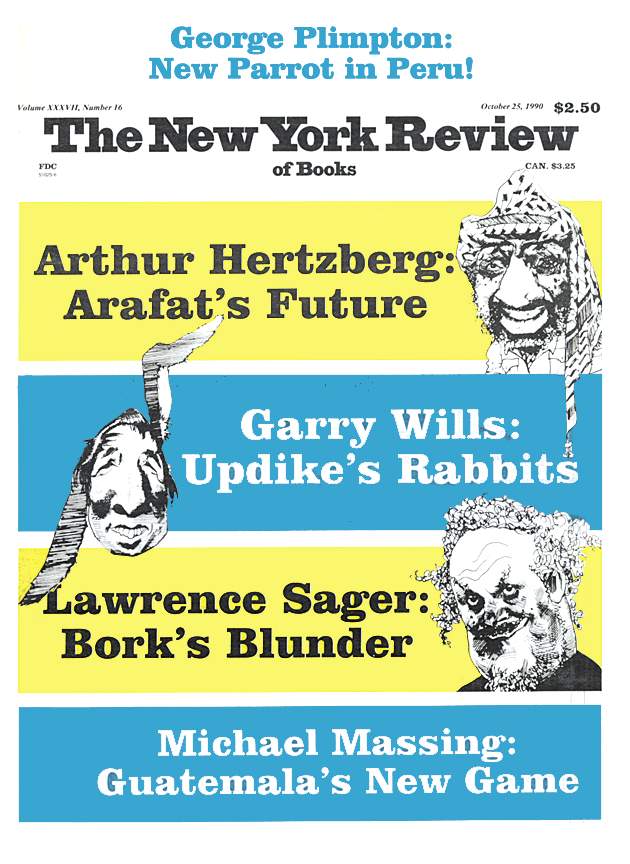In response to:
The Empire Strikes Back from the February 1, 1990 issue
To the Editors:
Anyone who was present in Tiananmen Square June 3–4, 1989, will, I am certain, agree with Jonathan Mirsky’s view of “the muddle and helter-skelter of the events” [“The Empire Strikes Back,” NYR, February 1].
Perhaps it is this “muddle and helter-skelter” which led him to suggest that I did not notice what he describes as “a mini-massacre” outside the Beijing hotel just down the street from Tiananmen at or about 10:20 AM Sunday morning, June 4.
Mirsky says he saw 20 or 30 people shot outside the hotel at that moment. He adds that my Tiananmen Diary: 13 Days in June does not mention the “mini-massacre.” Perhaps my watch was a little faster than his but my entry for 10:30 AM notes:
A very sharp spray of machinegun fire. The people had been running and wheeling their bicycles rapidly from Tiananmen when the burst exploded. I was looking out the window and ducked behind the wall. When I carefully put my head a bit forward to look down on Chang-an I saw two people lying on the pavement just outside…. An ambulance pulled up and first one victim and then the other was loaded on. There was blood on the pavement after the ambulance left. I would guess that one victim was dead or near it, the other perhaps not. So the shooting of citizens and students goes on.”
I did not see 20 or 30 victims although my view from the balcony of room 735 in the Beijing hotel allows a broad view of Changan street. True, in the course of the day nearly 100 persons were killed or wounded by random shooting of the PLA picket line. Of course I don’t know Mirsky’s point of observation from the Beijing hotel.
If, as Mirsky suggests, I was sleeping during all this I must be an accomplished somnambulist.
Harrison E. Salisbury
Florence, Italy
Jonathan Mirsky replies:
I am sorry I didn’t mention accurately Mr. Salisbury’s report of what happened outside his window between 10:20 and 10:30 on June 4. He said he would “guess” that one person was dead. I was on the pavement watching this episode throughout, as were, among others, Andrew Higgins and Margaret Herbst. Higgins describes “…a hundred yard length of corpses, abandoned bicycles, and prone terrified survivors” (Tiananmen: The Rape of Peking, p. 127). Ms. Herbst says: “…at least fifty people died right there.” (Simmie and Nixon, Tiananmen Square, p. 194.) Mr. Salisbury says that at 10:40 he stood on the front steps of the Peking Hotel. Even then he was unable to discover what had just happened only a few yards away.
I didn’t say that Mr. Salisbury slept through that event, but through “the critical events of the weekend.” These were the attempt on the night on June 2–3 by several thousand young, unarmed soldiers to enter the square before they were chased away by angry civilians, and the killings on the night of June 3–4. On the morning of June 3, Mr. Salisbury’s diary records “I had slept soundly” (p. 17), and on the night of the killings he “hit the bed and collapsed in a deep sleep.” Between 2 and 3 AM, after the main killing was over “…I half awoke and said ‘Oh fuck!’ and turned over” (p. 43). At 4:30 AM, unable to find the BBC, he tunes in to VOA and gets his first information about the scale of what he missed. He stands on his balcony and peers into the darkness. “What is going on?” he wonders. “…Have the big armoured columns finally made it into the center?” (p. 45). Indeed they had. At least five hours earlier.
I am not impugning Mr. Salisbury’s courage. He just missed the story. What he has written about his five days in Peking makes only more puzzling his assertion that “I think I know China as well, if not better, than any member of the Standing Committee of the Politburo” (pp. 3–4).
This Issue
October 25, 1990


